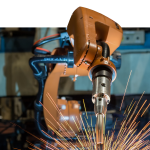Nano-coating tech — the emerging market for ‘extreme’ IIoT?

The Industrial Internet of Things (IIoT) — the catchall term for the connection between machinery, advanced analytics, and people — is permeating a multitude of industries at a rapid rate.
IIoT is the technological driving force of the ‘Industry 4.0’ concept and is predicted to be worth US$1 trillion by 2022. It’s bridging a new relationship between Information Technology (IT) and Operational Technology (OT), ultimately changing and upgrading the way that industrial outfits operate from day-to-day.
Now, networks of connected sensors can feedback information from equipment. To point to just several examples, that can include enabling analytics to predict maintenance schedules — such as detecting corrosion inside a refinery pipe before real damage takes place; enabling machine-to-machine communication to ensure uptime is optimized and orchestrated or feeding real-time data back into the product design cycle to enhance product development.
There are hoards of applications across manufacturing, chemicals, food and beverage, energy, automotive and many more — all of which are reaping the benefits.
But, as the power of IIoT continues to be realized across a broader swathe of applications and the cost of sensors continue to fall, IIoT hardware that has currently been in relatively ‘benign’ conditions will increasingly be exposed to environments that begin putting it to the test.
“[…] we’re increasingly seeing devices being deployed in extreme environments such as outer space, deserts, and the deep sea,” Dr. Christopher Cogswell, Customer Consultant at global information analytics business Elsevier wrote in The Engineer.
“The IIoT has the potential to be a goldmine of scientific insight,” Cogswell continued, particularly in the hands of geologists and meteorologists, who can use the technology to gain insights and help tackle challenges from climate change and natural disasters.
“Yet, however wide the network and however high the number of sensors connected, the IIoT will only be useful if the sensors are working and able to transmit data.
“Protecting and maintaining these sensors is, therefore, set to be one of the biggest engineering challenges of the next decade,” he said.
While current IIoT equipment is hardly delicate — it’s designed to withstand the pressures and strains of heavily-industrial environments and systems, there is increasing demand to take this technology to inhospitable environments that would test the full functionality of most existing IIoT technology.
Cogswell cited three environments which are pushing the working limits of IIoT sensors, through factors such as heat, humidity, pressure, and sunlight.
# 1 | Outer space
One of the most efficient places to gather climate data and monitor global weather systems is from outer space.
However, if you consider the astronomical cost of research and development that goes into space programs, it’s unsurprising that equipment that may survive a warehouse won’t survive so well outside the earth’s atmosphere. “The difference of even a micron thickness in the coating can cause problems which result in breaches and corrosion of the underlying substrate,” said Cogswell.
YOU MIGHT LIKE

‘Sparks will fly’ in IIoT integration culture clash
# 2 | Desert
As we progress further towards renewable sources of energy, the endless space and bleaching sunlight of deserts make them the ideal ground for solar farms. The Desert Sunlight Solar Farm is California’s Mojave Desert, for example is 16 square kilometers in size.
Like other industries, these systems are turning to IIoT technology to optimize operations. Of course, this means for the equipment to function, it needs to be able to withstand wild temperature fluctuations and be able to resist abrasive sandstorms, where winds can travel up to 80mph.
# 3 | Deep sea
While we famously know less about the ocean floor than we do the moon, the capabilities of oceanographic research is continually being advanced by new technology. While less than 20 percent of the world’s seabeds have been mapped, the collaborative Seabed 2030 Project seeks to map the entire world’s oceans by 2030.
Much of this exploration will rely on battery-free sensors, but success here — and in a range of similar deployments, such as by the oil & gas industry — will be reliant on developing sensors that can withstand crushing pressure and the corrosive effects of seawater.
According to Cogswell, anti-corrosion coating will be so crucial to the proliferation of IoT devices in more demanding environments, it will drive a market worth nearly US$25 billion by 2024.
This is not completely new though, technologies such as nano-coating have seen a rise in demand on the consumer side too, as the technology we use and carry around with us daily becomes less ‘hallowed’, and is expected to be rough and ready. Apple now markets its iPhones on durability and water resistance, for example, with liquid damage the second most common cause of handset damage behind cracked screens.
In a similar capacity, as an increasing weight of trust is placed in IIoT technology across industries, the reliability of the hardware must also be assessed — particularly in regard to its ability to withstand its environment at the most economical price point and stand the test of time.









